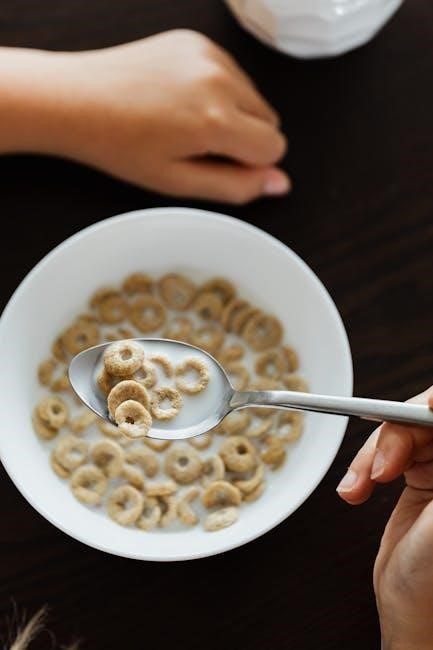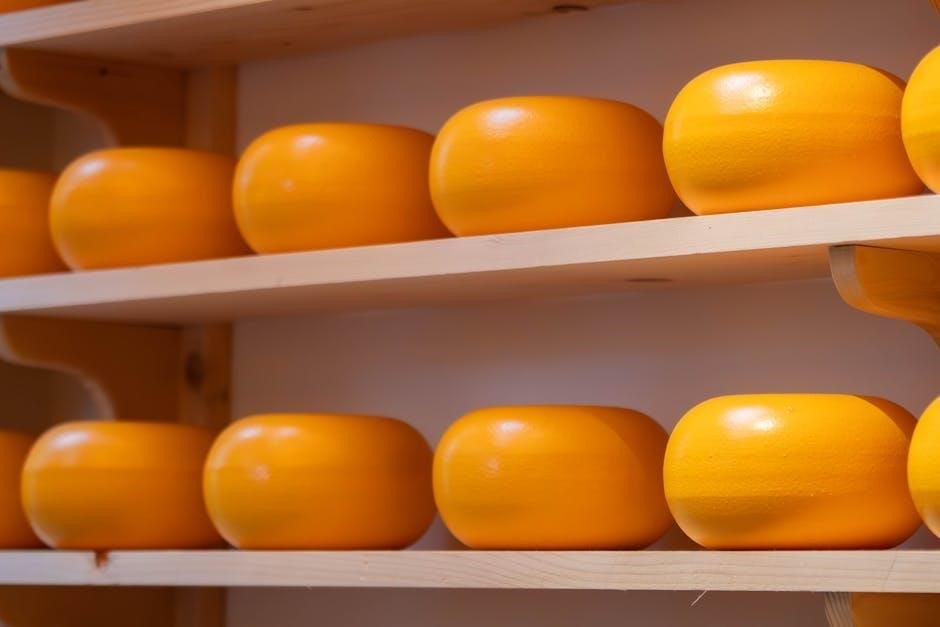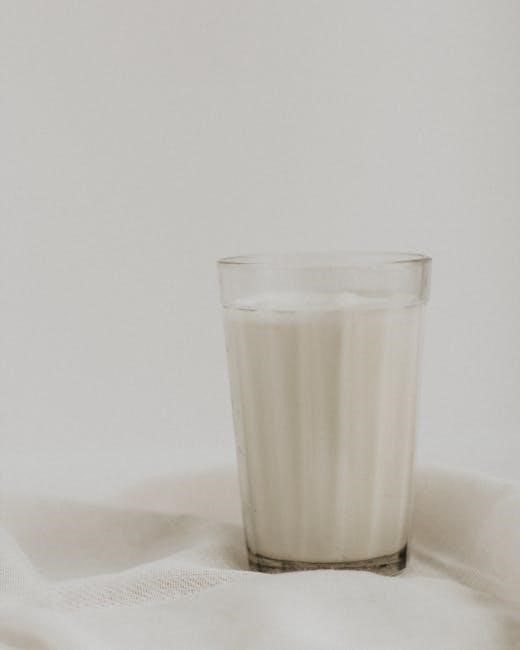A lactose-free diet eliminates or reduces lactose, a sugar in milk, often due to intolerance; It helps manage symptoms and requires careful label reading to avoid hidden lactose sources․
1․1 What is Lactose?
Lactose is a naturally occurring sugar found in milk and dairy products․ It serves as an essential energy source, particularly for infants․ However, some people struggle to digest lactose due to insufficient lactase enzyme production, leading to lactose intolerance․ Lactose is also present in hidden forms in various processed foods, making it crucial to identify and avoid such products when following a lactose-free diet․ Understanding lactose is the first step in managing dietary restrictions and ensuring proper nutrition while avoiding discomfort caused by lactose intolerance․
1․2 Why People Choose Lactose-Free Diets
People choose lactose-free diets primarily to manage lactose intolerance, a condition where the body cannot properly digest lactose due to low levels of the enzyme lactase․ This often results in uncomfortable symptoms like bloating, gas, and diarrhea․ Additionally, some individuals opt for lactose-free diets due to personal preferences, digestive sensitivities, or dietary restrictions․ By eliminating lactose-containing products, individuals can avoid these discomforts while maintaining a balanced and nutritious diet․ Lactose-free diets are also beneficial for those who wish to reduce their reliance on dairy products, making it a popular choice for various health and lifestyle reasons․
1․3 Benefits of a Lactose-Free Diet
A lactose-free diet offers numerous benefits, particularly for those with lactose intolerance․ It alleviates symptoms like bloating, gas, and diarrhea, improving overall digestive comfort․ By removing lactose-containing products, individuals can enjoy a diet that minimizes discomfort while still providing essential nutrients․ Lactose-free diets also encourage the exploration of diverse, nutrient-rich foods, ensuring a balanced intake of vitamins and minerals․ Additionally, this dietary approach supports long-term gut health and well-being, making it a sustainable choice for those managing lactose intolerance or preferring dairy-free options․

Understanding Lactose Intolerance
Lactose intolerance occurs when the body lacks the enzyme lactase, needed to digest lactose in dairy products, leading to digestive discomfort and symptoms like bloating and gas․
2․1 What is Lactose Intolerance?

Lactose intolerance is a condition where individuals struggle to digest lactose, a sugar found in milk and dairy products․ It occurs due to a deficiency of lactase, the enzyme that breaks down lactose․ Without enough lactase, undigested lactose remains in the gut, leading to uncomfortable symptoms like bloating, gas, diarrhea, and stomach cramps․ This condition can be congenital or develop over time, often due to reduced lactase production as people age․ It varies in severity and affects people differently, with some able to tolerate small amounts of lactose while others must avoid it entirely․ Understanding this condition is key to managing its impact․
2․2 Symptoms of Lactose Intolerance
The symptoms of lactose intolerance typically appear within 30 minutes to a few hours after consuming lactose-containing products․ Common symptoms include bloating, gas, diarrhea, and stomach cramps․ Some individuals may also experience nausea or vomiting․ The severity of these symptoms varies depending on the amount of lactose consumed and the individual’s level of lactase enzyme deficiency․ In severe cases, symptoms can be debilitating, while others may only experience mild discomfort․ Recognizing these symptoms is crucial for proper diagnosis and effective management of the condition to avoid unnecessary discomfort and complications․
2․3 How to Diagnose Lactose Intolerance
Diagnosing lactose intolerance involves a combination of clinical evaluation, dietary elimination, and specific tests․ A healthcare provider may start by reviewing symptoms and medical history․ The hydrogen breath test is commonly used, measuring breath hydrogen levels after consuming a lactose-rich drink․ Elevated levels indicate undigested lactose․ Stool acidity tests, particularly in children, can also detect lactose malabsorption․ Elimination diets, where lactose-containing foods are removed and reintroduced, help identify symptom triggers․ These methods collectively confirm the presence of lactose intolerance, guiding appropriate dietary adjustments for relief and improved digestion․
Dairy Alternatives
Dairy alternatives offer lactose-free options, catering to those avoiding traditional dairy․ Popular choices include almond, soy, oat, and coconut milk, providing similar nutritional benefits without lactose․
3․1 Lactose-Free Milk Options
Lactose-free milk is a great alternative for those with lactose intolerance․ It is made by adding lactase, an enzyme that breaks down lactose, making it easily digestible․ Brands like Lactaid and Organic Valley offer lactose-free milk options․ These milks are rich in calcium, vitamin D, and protein, similar to regular milk․ They are ideal for cooking, baking, or consumption, providing a seamless transition for those avoiding lactose․ Always check labels to ensure they are 100% lactose-free and suitable for your dietary needs․
3․2 Non-Dairy Milk Alternatives (e․g․, Almond, Soy, Oat Milk)
Non-dairy milk alternatives are excellent options for those avoiding lactose․ Almond milk, soy milk, and oat milk are popular choices, offering a creamy texture without dairy․ These milks are naturally lactose-free and often fortified with calcium, vitamin D, and other nutrients․ Coconut milk and cashew milk are also great alternatives, though they may have higher calorie counts․ When shopping, opt for unsweetened varieties to avoid added sugars․ These options are versatile for cereal, smoothies, or baking, making them ideal for a lactose-free lifestyle․ Always check labels to ensure they meet your dietary needs and preferences․
3․3 Lactose-Free Cheese and Yogurt
Lactose-free cheese and yogurt are ideal for those with lactose intolerance or dairy sensitivities․ These products are made by removing lactose or adding lactase enzyme to break it down․ Hard cheeses like cheddar and Swiss naturally have less lactose, while soft cheeses like mozzarella and cottage cheese often come in lactose-free versions․ Yogurt brands now offer lactose-free options, sometimes fortified with probiotics․ Always check labels to confirm they are lactose-free․ These products provide the same nutritional benefits as traditional dairy, making them great for recipes, snacks, or meals without the discomfort of lactose intolerance․
Lactose-Free Food Categories
Lactose-free diets encompass a variety of food groups, including fruits, vegetables, proteins, grains, and naturally lactose-free dairy alternatives․ These categories ensure balanced nutrition without discomfort․
4․1 Fruits
Fruits are a natural and essential part of a lactose-free diet, offering vitamins, minerals, and antioxidants․ Most fruits are lactose-free, making them ideal for those avoiding dairy․ Popular options include apples, bananas, berries, oranges, and tropical fruits like mangoes and pineapples․ Fruits are versatile, serving as healthy snacks, desserts, or additions to meals․ They provide essential nutrients like vitamin C, potassium, and fiber, supporting overall health․ Incorporating a variety of fruits ensures a balanced diet while adhering to lactose-free requirements․
4․2 Vegetables
Vegetables are a cornerstone of a lactose-free diet, offering a wide variety of flavors and nutrients․ Most vegetables are naturally lactose-free, making them an excellent choice for those avoiding dairy․ Leafy greens like spinach, kale, and broccoli are rich in vitamins and minerals․ Cruciferous vegetables such as cauliflower and Brussels sprouts provide essential antioxidants․ Root vegetables like carrots, potatoes, and sweet potatoes are versatile and nutrient-dense․ Colorful options like bell peppers and tomatoes add vibrancy to meals․ Vegetables are also low in calories and high in fiber, promoting digestive health and overall well-being․
4․3 Proteins (Meat, Fish, Eggs)
Proteins such as meat, fish, and eggs are excellent lactose-free options, providing essential nutrients like iron, zinc, and B vitamins․ Lean meats like chicken, turkey, and beef are versatile and can be prepared in various ways․ Fish, including salmon, tuna, and cod, offers omega-3 fatty acids for heart health․ Eggs are a convenient and protein-rich choice․ All these options are naturally free from lactose, making them ideal for lactose-free diets․ They also pair well with other lactose-free foods, ensuring balanced nutrition without dairy․ Incorporating a variety of proteins helps maintain diversity and satisfaction in meals․
4․4 Grains and Starches
Grains and starches are excellent lactose-free options, providing fiber, vitamins, and energy․ Rice, quinoa, oats, and barley are versatile and naturally free from lactose․ These can be used in main dishes, sides, or as bases for salads․ Starchy vegetables like potatoes, corn, and sweet potatoes are also lactose-free and rich in nutrients․ Whole grains offer more nutritional value compared to refined options․ Incorporating these into meals ensures a balanced diet without dairy․ They can be prepared in various ways, making them a flexible choice for lactose-free eating․ Grains and starches are ideal for maintaining energy levels and overall health․
Hidden Sources of Lactose
Lactose can be found in unexpected foods like processed meats, bread, medications, and cosmetics․ Always check labels to avoid hidden dairy derivatives and ensure compliance with a lactose-free diet․ Avoid products with casein, whey, or lactose-based ingredients․ Be cautious of food additives and preservatives that may contain lactose․ This section helps identify and avoid such hidden sources, ensuring a strict lactose-free lifestyle․ Awareness is key to maintaining a lactose-free diet effectively․ Never assume a product is lactose-free without verification․ Stay vigilant and informed to avoid accidental lactose consumption․
5․1 Food Additives Containing Lactose
Many food additives, such as whey, casein, and lactose monohydrate, contain lactose․ These ingredients are often found in processed foods like energy bars, cereals, and instant soups․ Even some medications and supplements may include lactose as a filler․ Always check labels for terms like “milk derivatives” or “lactose-based ingredients․” Avoid products with hidden dairy by-products, as they can trigger intolerance symptoms․ Using a lactose-free food list PDF can help identify safe alternatives and ensure compliance with your dietary restrictions․ Stay vigilant to prevent accidental lactose consumption from unexpected sources․
5․2 Processed Foods to Avoid
Processed foods often contain hidden lactose, making them unsuitable for a lactose-free diet․ Common culprits include bread, crackers, granola, energy bars, and ready-to-eat meals․ Many processed snacks, such as chips and pretzels, may also contain dairy by-products․ Additionally, some cooking mixes, like instant soups and sauces, often include lactose․ Always check labels for terms like “whey,” “casein,” or “lactose” to avoid accidental consumption․ Referencing a lactose-free food list PDF can help identify safe alternatives and guide your shopping decisions․ Avoiding these processed foods is key to maintaining a lactose-free lifestyle and preventing intolerance symptoms․
5․3 Reading Food Labels for Lactose

Reading food labels is crucial for identifying lactose in products․ Look for terms like “whey,” “casein,” “lactose,” or “milk” in the ingredient list․ Be aware of hidden sources, such as milk derivatives in additives or flavorings․ Many products, including bread, cereals, and processed meats, may contain dairy․ Check for “may contain milk” warnings, as cross-contamination can occur․ Always opt for certified lactose-free or dairy-free options․ A lactose-free food list PDF can serve as a quick reference guide․ Becoming label-savvy helps ensure compliance with your dietary needs and prevents accidental lactose intake․

Snacks and Desserts
Explore lactose-free snacks and desserts with options like nuts, fruits, and dark chocolate․ Enjoy dairy-free ice cream and baked goods for delicious treats anytime․
6․1 Lactose-Free Snack Options
Lactose-free snacks are ideal for those with intolerance or preferences․ Options include fresh fruits like apples and bananas, nuts such as almonds and walnuts, and seeds like sunflower or pumpkin․ Veggie sticks with hummus are a healthy choice, while lactose-free granola bars or crackers provide convenience․ Homemade snacks like trail mix with dried fruits and nuts are also great․ Always check labels for hidden lactose in store-bought items․ These snacks are easy to prepare and offer a variety of flavors to keep your diet exciting and satisfying without compromising on nutrition or taste․
6․2 Dairy-Free Desserts
Dairy-free desserts offer delicious alternatives for those avoiding lactose․ Indulge in vegan chocolate brownies, fruit-based sorbet, or coconut milk puddings․ Chia pudding with almond milk and honey is a healthy option․ Baked goods like cupcakes or cookies can be made with non-dairy milk and vegan butter․ Sorbet made from fresh fruit is naturally lactose-free․ Store-bought options like dairy-free ice cream or vegan cheesecakes are widely available․ Always check labels for hidden lactose in processed treats․ These desserts allow you to enjoy sweet treats without compromising your dietary preferences or restrictions․

Meal Planning and Grocery Shopping
Effective meal planning involves creating weekly menus and grocery lists focused on lactose-free items․ Prioritize fresh produce, lean proteins, and whole grains․ Always check food labels for hidden lactose and use a lactose-free food list PDF as a guide to ensure compliance with dietary preferences or restrictions․ This organized approach simplifies shopping and meal preparation, making it easier to maintain a lactose-free lifestyle․ Plan ahead to avoid last-minute purchases that may not align with your dietary goals․ Stay organized and enjoy a variety of nutrient-rich meals․
7․1 Tips for Grocery Shopping
When shopping for lactose-free products, plan ahead with a detailed list based on a lactose-free food list PDF․ Always read food labels to identify hidden lactose in ingredients like whey or casein․ Opt for certified lactose-free or non-dairy alternatives, such as almond or oat milk․ Stick to familiar brands that cater to lactose-free diets to ensure safety․ Explore international or specialty sections for additional options․ Shop the store’s perimeter for fresh, naturally lactose-free items like fruits, vegetables, meats, and grains․ Avoid impulse buys and focus on pre-planned essentials to maintain your dietary preferences effectively․
7․2 Meal Planning Ideas
Plan meals in advance to ensure variety and nutrition․ Use a lactose-free food list PDF to identify ingredients for balanced meals․ Start with breakfast ideas like lactose-free milk smoothies or gluten-free oatmeal․ For lunch, incorporate lean proteins such as grilled chicken or fish, paired with quinoa or brown rice and steamed vegetables․ Dinners can feature stir-fries with non-dairy sauces or roasted meats with lactose-free seasonings․ Snacks like nuts, fruits, or lactose-free yogurt keep energy levels steady․ Rotate ingredients weekly to avoid monotony and ensure you’re meeting nutritional needs without compromising flavor or convenience․

Lactose-Free Recipes
This section provides comprehensive guides for preparing delicious lactose-free dishes, ensuring variety and nutrition while catering to dietary restrictions․ Explore creative, easy-to-follow recipes for all meals․
8․1 Breakfast Recipes
Start your day with delicious lactose-free breakfast options like almond milk pancakes, coconut yogurt parfaits, or chia pudding․ Enjoy lactose-free smoothies with fresh fruits and non-dairy milk․ Try scrambled eggs with spinach or avocado toast for a protein-packed start․ Oatmeal with nut butter and berries is another tasty choice․ For a sweeter treat, opt for lactose-free muffins or banana bread․ These recipes ensure a nutritious and flavorful morning without dairy, perfect for those with lactose intolerance or preferences․ Explore creative twists on classic breakfast dishes to keep your meals exciting and satisfying․
8․2 Lunch and Dinner Ideas
For a satisfying lactose-free lunch, try grilled chicken or fish with roasted vegetables, or a hearty quinoa salad with fresh herbs․ Stir-fries with tofu or shrimp, cooked in non-dairy milk or coconut milk, are flavorful options․ Consider lentil soup or vegetable curry for a comforting meal․ Dinner ideas include baked salmon with asparagus, stuffed bell peppers with rice and beans, or zucchini noodles with pesto sauce․ These meals are naturally lactose-free, ensuring a diverse and delicious diet․ Explore global cuisines like Mexican or Asian for inspiration, as they often rely on dairy-free ingredients, making meal planning easy and enjoyable․

Supplements and Alternatives
Discover supplements and alternatives for a lactose-free diet․ Explore lactase enzyme supplements and calcium, vitamin D alternatives․ These options ensure proper nutrition needs without dairy․
9․1 Lactase Enzyme Supplements
Lactase enzyme supplements are a popular solution for managing lactose intolerance․ These enzymes mimic the body’s natural lactase, breaking down lactose in dairy products․ Available in capsules, tablets, or drops, they can be taken before consuming lactose-containing foods․ They are especially useful for occasional dairy consumption․ Many brands offer lactase supplements, which can be found in health stores or online․ Always follow the recommended dosage to ensure effectiveness․ These supplements are a convenient alternative for those who want to enjoy dairy without discomfort․ They are also included in some lactose-free food list PDF guides as a helpful resource for managing dietary restrictions․
9․2 Calcium and Vitamin D Alternatives
For those following a lactose-free diet, ensuring adequate calcium and vitamin D intake is crucial․ Dairy products are primary sources of these nutrients, but alternatives are available․ Fortified plant-based milks, such as almond, soy, or oat milk, are excellent sources of calcium and vitamin D․ Leafy greens like kale and broccoli also provide calcium, while fatty fish like salmon offer vitamin D․ Tofu and fortified cereals are additional options․ Many lactose-free food list PDF guides highlight these alternatives, making it easier to plan a balanced diet without dairy․ These options help maintain bone health and overall wellness․

PDF Resources for Lactose-Free Diets
PDF resources provide comprehensive guides for lactose-free diets, including detailed food lists, meal plans, and tips․ These guides are often available on health websites or organizations․

10․1 Printable Lactose-Free Food Lists
Printable lactose-free food lists are essential for managing dietary restrictions․ These PDF guides detail lactose-free options, including dairy alternatives, fruits, vegetables, proteins, and grains․ They often categorize foods by lactose content and provide serving sizes for easy reference․ Many lists are downloadable from health websites or nutrition organizations․ They may also include tips for reading labels and avoiding hidden lactose in processed foods․ These resources are invaluable for meal planning and grocery shopping, ensuring individuals with lactose intolerance or sensitivity can make informed choices․ Always check for updates to get the most accurate and current information․
10․2 Where to Find Reliable PDF Guides
Reliable lactose-free food list PDFs can be found on reputable health and nutrition websites․ Organizations like the National Institute of Diabetes and Digestive and Kidney Diseases or the Academy of Nutrition and Dietetics often provide downloadable resources․ Additionally, registered dietitians and lactose intolerance support groups share comprehensive guides․ Educational institutions and healthcare providers may also offer free PDFs․ When searching, ensure the source is credible and the information is up-to-date․ Look for guides endorsed by medical professionals or nutrition experts to guarantee accuracy and practicality for managing lactose-free diets effectively․
Adopting a lactose-free diet is manageable with the right resources․ A lactose-free food list PDF provides essential guidance, ensuring nutrition and clarity in daily food choices․
11․1 Summary of Key Points
A lactose-free diet is essential for those with intolerance, offering numerous health benefits like improved digestion and reduced discomfort․ This guide provides a comprehensive lactose-free food list PDF, detailing dairy alternatives, fruits, vegetables, proteins, and grains․ It highlights hidden lactose sources in processed foods and additives, emphasizing the importance of label reading․ Practical tips for meal planning, grocery shopping, and recipe ideas are included, along with supplements like lactase enzymes․ The PDF resource ensures a well-rounded approach, making it easier to follow a lactose-free lifestyle while maintaining nutritional balance and variety in daily meals․
11․2 Final Tips for a Successful Lactose-Free Diet
Adopting a lactose-free lifestyle requires careful planning and awareness․ Always refer to a reliable lactose-free food list PDF for guidance․ Plan meals around naturally lactose-free foods like fruits, vegetables, and proteins․ Explore dairy alternatives and non-dairy products to maintain variety․ Be vigilant about hidden lactose in processed foods by reading labels․ Incorporate lactase enzyme supplements if needed․ Stay consistent with your diet to avoid discomfort․ Lastly, consult a healthcare professional or dietitian for personalized advice․ With dedication and the right resources, a lactose-free diet can be both enjoyable and beneficial for long-term health․



